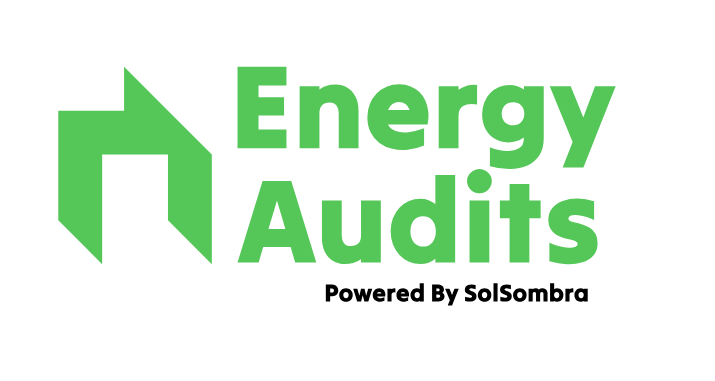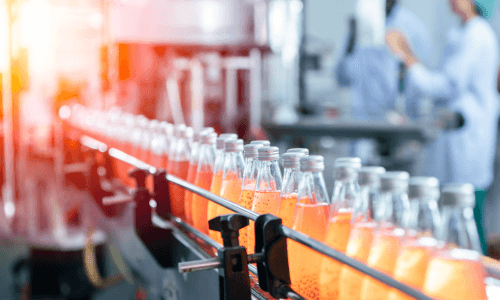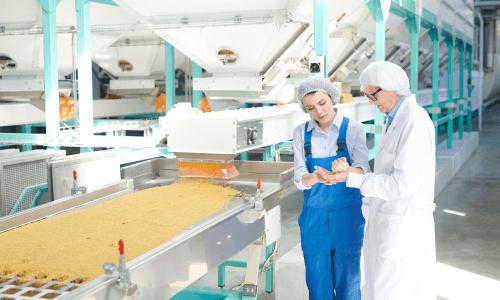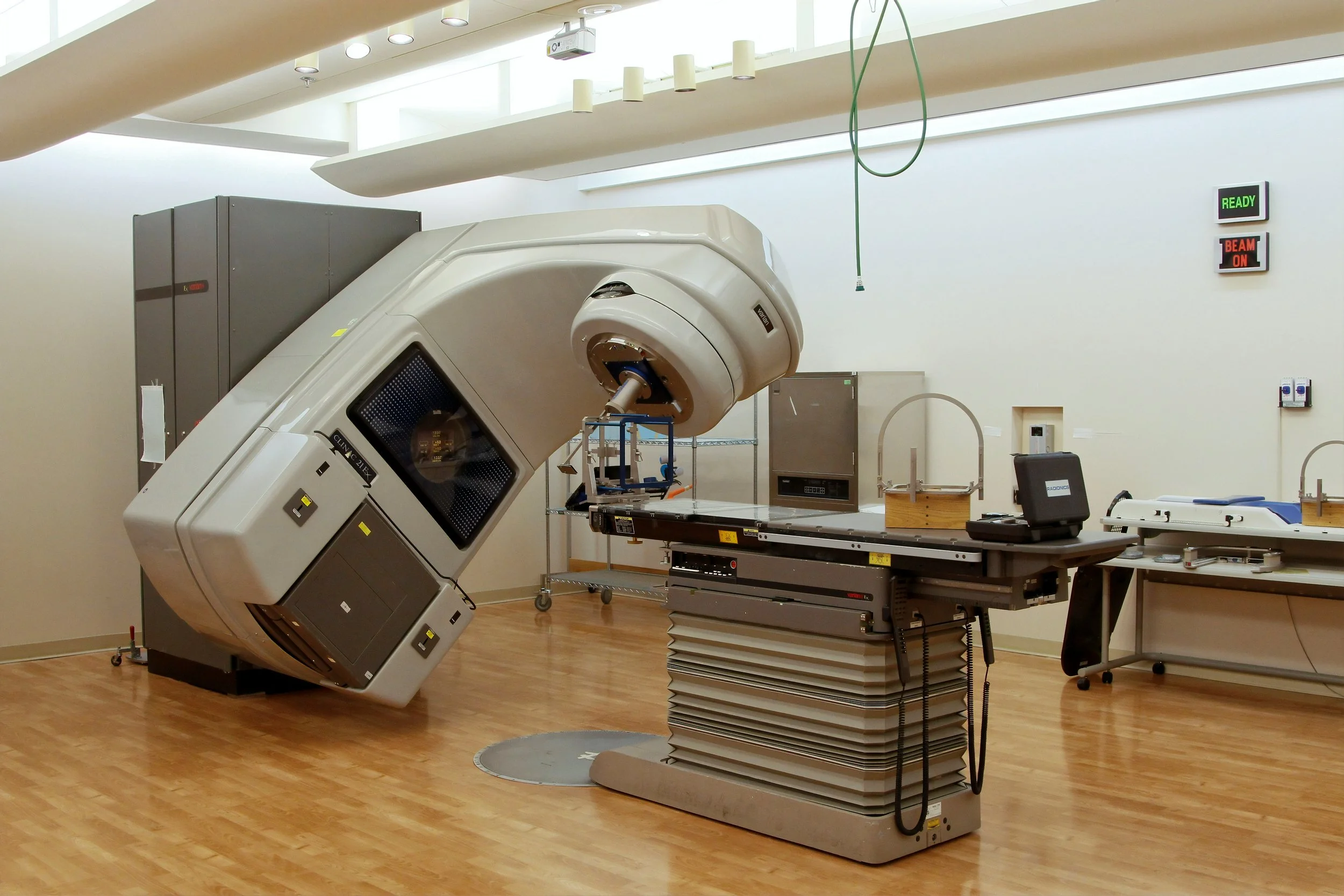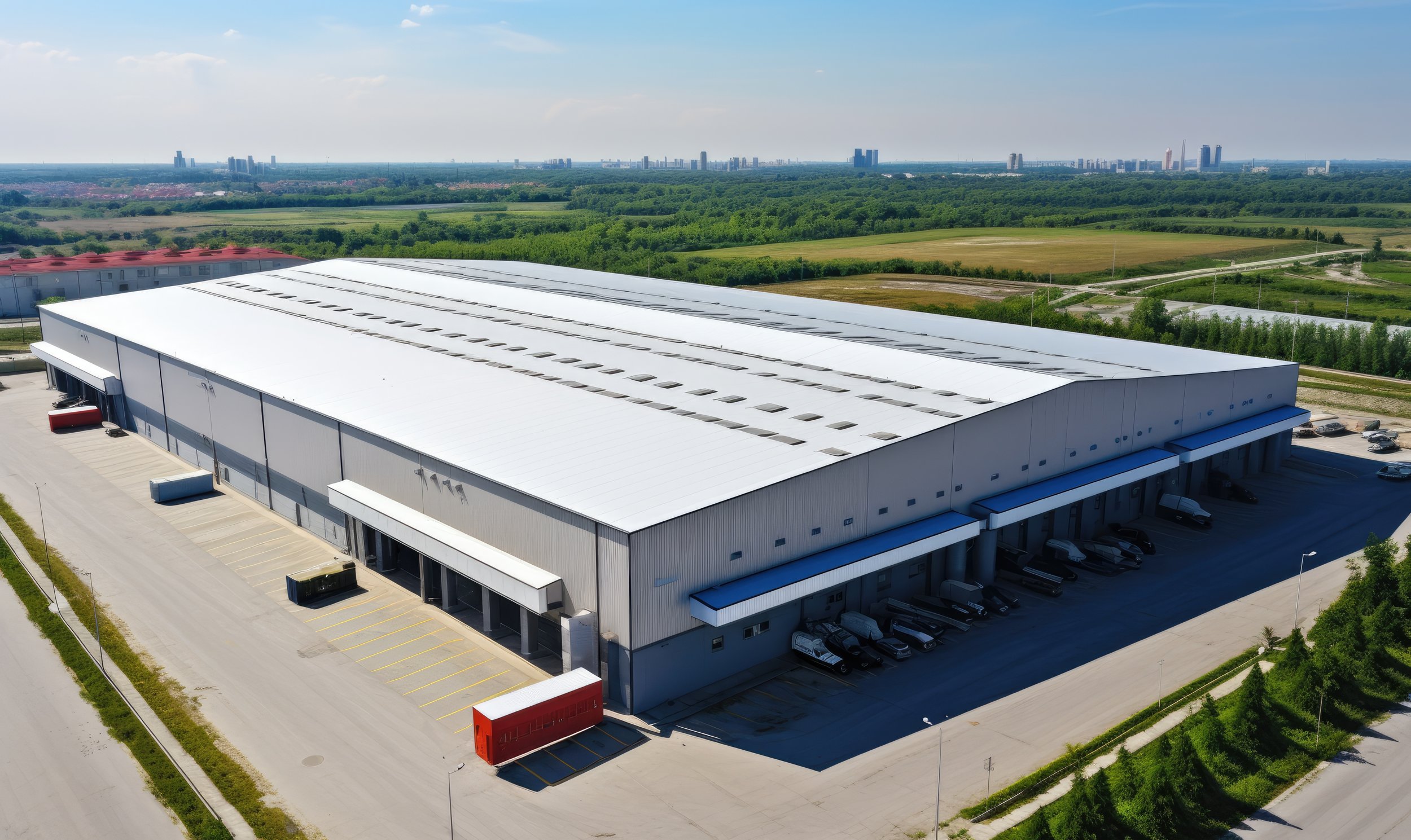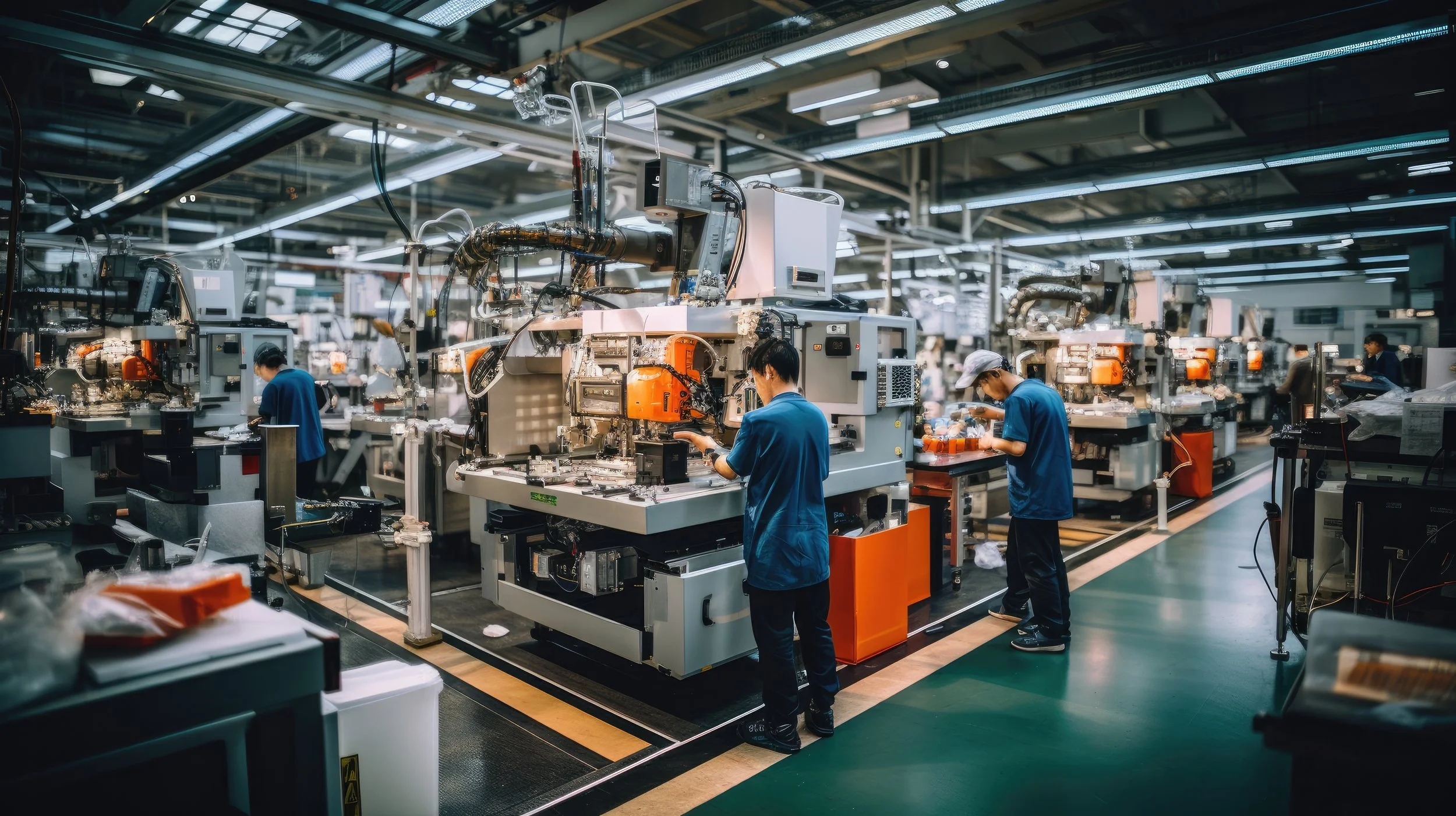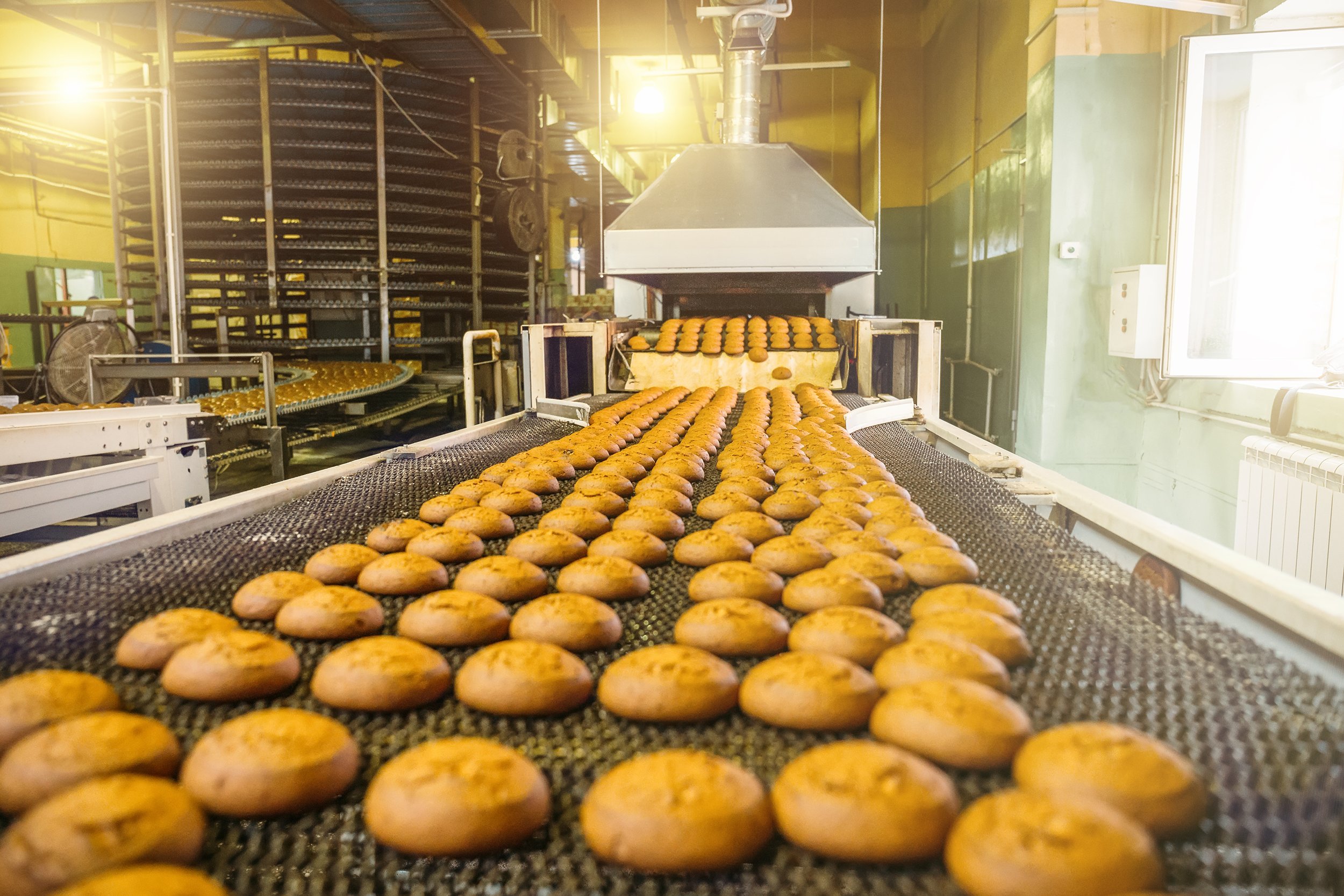
Energy Audits for
Food and Beverage
Get in Touch
Energy Use in Food & Beverage
The food and beverage industry is one of the most energy-intensive sectors, relying heavily on processes such as refrigeration, cooking, heating, cooling, drying, boiling, sterilization, packaging, and distribution. These processes involve significant use of electricity, natural gas, and sometimes other fuels like fuel oil or LPG. High energy costs, coupled with stringent regulatory standards for food safety and quality, pose unique challenges. In food processing plants, maintaining precise temperatures (whether keeping milk chilled or ovens at baking temperature) is non-negotiable, so equipment must run as needed to ensure product quality and compliance with health regulations. Many facilities also face rising energy bills due to inefficiencies in equipment and outdated energy management practices. For example, an old refrigeration system might run continuously to maintain temperature, or a fryer might not have proper insulation and lose heat. Energy can account for a sizable portion of operating costs in this sector – studies have shown it can be up to 15-30% of total production costs for food and drink manufacturers. This means the scope to ease pressure on profit margins through better energy usage is clear. Furthermore, as consumers increasingly demand sustainable practices, companies are motivated to reduce their energy use (and thus carbon footprint) to meet market expectations and potentially gain a competitive advantage.
Opportunities for Energy Efficiency
Energy audits in the food and beverage sector reveal significant opportunities to optimize energy use without compromising product quality:
Refrigeration System Optimization: Food and beverage facilities often have large refrigeration needs – whether it’s cooling milk, freezing vegetables, or keeping a brewery’s fermentation tanks at the right temperature. Upgrading refrigeration compressors to more efficient models or adding VFDs (Variable Frequency Drives) to allow capacity control can yield major savings. Implementing floating head pressure control (allowing condenser pressure to float down in cold weather) can reduce compressor work. Ensuring evaporator fan controls (slowing fans when full cooling isn’t needed, or off when compressors aren’t running) saves electricity. Regular maintenance, like cleaning condensers and evaporators, is low-hanging fruit that improves efficiency. Additionally, many processes produce waste cold (for example, chilling one product creates cold glycol that can be reused to pre-cool another stream). Heat exchangers can transfer cooling between process streams to maximize use of generated “cold.” In cold storage, simple measures like high-speed doors, strip curtains, and well-calibrated thermostats (not keeping a freezer colder than necessary) are often highlighted by audits.
Heat Recovery Solutions: Food and beverage processes frequently involve a lot of heating (ovens, cookers, pasteurizers, boilers for steam) and therefore produce waste heat. Installing heat recovery systems can capture this waste heat for useful purposes. For example, heat expelled from pasteurization cooling can preheat incoming product or wash water. Breweries often use heat exchangers to reclaim heat from boiled wort to preheat the next batch’s water. Many plants can use boiler economizers to capture flue gas heat to preheat feedwater. Another form of heat recovery is using cogeneration (CHP): using a gas engine or turbine to produce electricity on-site and then utilizing the waste heat for steam or hot water in the plant (common in large food factories, dairies, or sugar mills). Audits will pinpoint the most promising heat streams to target – sometimes a single exchanger on a furnace exhaust can save a huge amount of fuel.
Compressed Air Optimization: Compressed air is widely used in food plants (actuating valves, powering pneumatics in packaging machines, air blasts for cleaning or moving products) and is often generated by big compressors running 24/7. Finding and fixing leaks is usually the top recommendation (leaks can waste 20-30% or more of generated air). Installing a sequencer or master controller for multiple compressors ensures they operate efficiently together (avoiding having multiple partially loaded compressors, which is inefficient). Reducing the system pressure to the lowest acceptable level saves energy (every 1 bar reduction can save ~7% of energy). In some cases, using alternatives like blowers or fans instead of compressed air jets for cooling or drying can drastically cut energy (since compressed air is an expensive way to do those tasks).
Efficient Cooking/Heating Equipment: Many food processes involve cooking or heating – ovens, kettles, fryers, spray dryers, etc. Upgrading burners to high-efficiency or regenerative burners can save fuel. Ensuring proper insulation of tanks, ovens, piping, and boilers means less heat loss (a very cost-effective fix). Batch process optimization can avoid heating more product or water than needed. For example, if a batch process doesn’t always run at full capacity, using smaller auxiliary equipment for small batches instead of firing a huge boiler can save energy. Some plants can consider electrification of certain processes (especially if their electricity is coming from renewables) – e.g., using electric infrared ovens for some drying tasks, or heat pumps for moderate heating needs, which can be more efficient than boilers for low-temperature processes.
Renewable and Alternative Energy: Manufacturers are increasingly turning to bioenergy as one of the few low-carbon alternatives to natural gas for high-temperature processes. This could involve using biomass boilers fueled by agricultural waste (e.g., nut shells, fruit pits, spent grain) or generating biogas from organic effluents (many food plants have anaerobic digesters that treat waste water or by-products and produce biogas, which can be burned in boilers or engines). Also, solar thermal can be used to preheat water (for cleaning or certain process needs) reducing boiler load – especially in sunny climates, solar hot water systems can make a dent in the substantial hot water usage for cleanup and sterilization. On the power side, installing solar PV on plant roofs or nearby land can offset electricity used by motors, pumps, and refrigeration. A notable example is some dairies or wineries using solar plus battery storage to run daytime processes heavily on solar.
Process Monitoring and Control: Integrating sensors and controls on the production line can greatly aid efficiency. For example, using sensors in ovens or dryers to precisely measure moisture content can prevent over-drying (which wastes energy) – once the target is reached, heat input can be reduced. Using automatic controllers for CIP (Clean-in-Place) systems can optimize the water temperature and pumping duration, ensuring effective cleaning with minimal waste of hot water and chemicals. SCADA systems that monitor real-time energy use per unit produced can alert operators to anomalies – for instance, if a certain product run is using more energy than usual, there might be an equipment issue. These controls help maintain efficiency day in and day out, and catching deviations early prevents energy drift.
By addressing these areas – process monitoring, renewable integration, equipment upgrades, and waste heat recovery – manufacturers can substantially reduce their energy costs while minimizing their environmental impact. Importantly, all these measures are implemented while ensuring product integrity. Unlike generic commercial buildings, changes in a food plant must be carefully vetted to ensure they don’t risk contamination or quality. Fortunately, most energy measures either have no impact on product (like insulation or boiler efficiency) or they can even improve product consistency (like better temperature control).
Sustainability and Consumer Expectations
Consumers increasingly demand sustainable practices from the food and beverage sector, pushing companies to prioritize reducing their carbon footprint. This is driven by rising public awareness of climate change and environmental impact of food production. Many big food and drink brands have made public commitments to cut emissions and energy use. For example, global studies indicate the food sector accounts for about 30% of global energy consumption and roughly 20% of greenhouse gas emissions, so improvements here are crucial for broader climate goals.
Renewable energy solutions, such as solar power and utilizing biomass from food waste, can enhance sustainability efforts while reducing dependency on traditional energy sources. Food and beverage companies often have access to organic waste (peels, pulp, spent grain, wastewater sludge) that can be turned into energy. By doing so, they create a circular system: waste becomes fuel. This not only cuts energy costs but also solves waste disposal issues and reduces methane emissions that would arise from organic waste decomposing in landfills or lagoons. A number of breweries and fruit processors, for instance, use anaerobic digesters to generate biogas used in boilers or generators.
From a market perspective, companies that adopt visible sustainable practices can improve their brand image. Many consumers are willing to support brands that are eco-friendly, and retailers sometimes favor suppliers who align with their sustainability policies. For example, a supermarket might give preference or shelf space to products from a manufacturer that uses 100% renewable energy or has a lower carbon footprint (some are even labeling products with carbon or sustainability info).
Additionally, reducing energy and embracing renewables help companies prepare for future regulations or carbon pricing. It “future-proofs” operations in a world where there’s likely to be increasing scrutiny and possibly penalties for high emissions. Early adopters can also gain financially through renewable energy credits, government subsidies, or simply locking in energy cost savings.
From a workforce perspective, many employees, especially younger ones, prefer working for environmentally responsible companies. Thus, sustainability efforts can help in talent retention and corporate culture (employees take pride in working for a green company, and often employees contribute ideas to save energy or reduce waste when the culture encourages it).
Energy efficiency is often the first and most direct way to cut emissions for food and beverage companies. Every kilowatt-hour or MJ saved is directly less fuel burned and less CO₂ emitted. Coupling these efficiency gains with renewable energy adoption moves a company significantly towards “net zero” manufacturing. Some companies have even set goals for net-zero processing plants, using a combination of massive efficiency improvements and on-site/off-site renewable energy to eliminate or offset all emissions.
In summary, sustainability is becoming intertwined with competitiveness in the food and beverage industry. Energy audits and subsequent efficiency projects not only reduce operational costs, but also enable companies to meet the sustainability expectations of consumers, investors, and business partners (like major retailers or hospitality clients who buy their products). It also positions them as leaders in a market where environmental transparency is increasingly the norm (e.g., disclosure through CDP or meeting standards for ESG indices).
How Energy Audits Can Help Food & Beverage Businesses
At Energy Audits, we understand the unique energy demands of the food and beverage industry. Our audits help businesses identify inefficiencies, reduce costs, and adopt sustainable practices. A typical audit for a food/bev facility will:
Map the Energy Flow: We diagram how energy enters and is used in the plant – from the boiler room to process heat to cooling systems to packaging lines. This often highlights surprising imbalances (like one process might consume 50% of all gas, or one piece of equipment might be half the electric load). By mapping, we ensure all major uses are accounted for and scrutinized.
Assess Equipment Performance: Each major equipment (boilers, compressors, fryers, pasteurizers, chillers, evaporators, etc.) is evaluated for its efficiency, age, and condition. We might do combustion tests on boilers, measure oven exhaust temperatures, log power on motors, etc., to gauge performance against best practice or design specs.
Identify Process Integration Opportunities: We look for ways one process’s waste can fuel another. For example, if a plant is both boiling product and separately cooling another, can we recover heat from one to assist the other? These integrations are often highly efficient but require a systems view that our audit provides.
Product and Schedule Analysis: We consider production schedules and whether energy is being used in tune with production. If the plant has multiple lines or product types, we see if some lines could be run consecutively rather than simultaneously to lower peak demand, or if cleaning schedules could be staggered to avoid all heaters running at once. We also see if certain energy-intensive processes could be shifted to times of lower energy cost (like at night if on time-of-use tariffs, provided it doesn’t harm product or workforce efficiency).
Quality and Safety Considerations: Importantly, any recommendation must preserve quality and safety. We always double-check that reduced energy usage still means compliance with food safety (cooking temperatures, sanitation requirements, etc.). Often we find excess energy being used to build safety margins (e.g., heating something longer than necessary “just in case”). We verify the critical limits so that we can confidently suggest dialing it back to what’s truly required, not the overkill that wastes energy.
The result is a set of tailored solutions. For instance, the audit might reveal “If you install a regenerative burner on Oven A, you can save 20% of its gas use. This costs X and pays back in Y years.” Or “Your bottle cooler is running 24/7; add a timer or control to turn it off during downtime, saving Z kWh/year.” We may highlight maintenance fixes (like “evaporator fans are icing up due to defrost issues – fixing that will improve cooling efficiency and product temperature consistency”). We also often include no/low-cost suggestions: e.g., “reduce compressed air pressure from 8 bar to 7 bar plant-wide, which will still meet all machine requirements and cut compressor energy ~10%.”
From heat recovery to renewable integration, our solutions empower companies to meet regulatory standards, enhance energy efficiency, and align with sustainability goals while maintaining product quality and customer satisfaction. For example, implementing a heat recovery might allow a plant to reuse waste heat to warm process water, meaning the boiler fires less but pasteurization still happens correctly – the product quality remains high, just achieved more smartly. Similarly, switching to LED lighting in inspection areas can improve visibility of products (good for quality control) while saving energy and reducing heat that might warm a refrigerated area.
After implementing audit recommendations, a food/bev company often sees a multi-faceted win: lower utility bills (improving margins), easier compliance with any energy or emissions regs, a marketing narrative around sustainability (which can be used on packaging or CSR reports), and possibly improvements in process control and reliability (since inefficiencies often coincide with variability or maintenance issues).
Manufacturers have the potential to significantly reduce their energy costs through these tailored energy audits and strategic upgrades. Many of our clients in this sector see it as finding “hidden profit” – money that was literally being burned or vented away can be reinvested in product innovation, marketing, or price competitiveness. In an industry often dealing with slim margins and high competition, that is crucial.
Artisanal and Small Producers (SMEs): We assist smaller-scale producers – like microbreweries, craft distilleries, family-owned bakeries, or dairy cooperatives – where budgets are limited and every dollar counts. Our audits for these operations focus on bang-for-buck improvements: for instance, a microbrewery might get the advice to use a heat exchanger to recover heat from the boil to preheat the next batch’s water (saving fuel) and to insulate their fermentation tanks better (keeping temperatures stable with less cooling). A small bakery might be guided to use timers on proofing ovens or invest in a more efficient mixer motor. Even if these businesses consume far less energy than a multinational plant, the relative impact on their expenses can be huge, and often these changes also improve the consistency of their craft (e.g., steadier fermentation temps can improve beer quality).
Government-Funded Food Operations: Some food-related operations are run by governments or in public institutions – examples include large hospital kitchens, prison bakeries, school meal preparation facilities, or research/training food processing labs in educational institutions. We provide audits for these to ensure public funds are used efficiently and to help meet public sector sustainability targets. For instance, a central production kitchen that makes meals for a school district could implement solar hot water and more efficient steamers based on our audit, saving taxpayer money and making the kitchen a demonstrator of modern sustainable practices (which can educate students and staff). In research or teaching facilities, where budgets might be tight, we might recommend leveraging grants to upgrade old energy-intensive equipment to newer models that provide better experimental control and lower energy use – aligning with both educational mission and cost-saving.
Large Food & Beverage Corporations: Big food and beverage companies (think major breweries, global snack or beverage brands, large meat processing plants, etc.) typically have numerous facilities and significant resource to invest. We work with these corporations to audit key plants and often to develop company-wide energy efficiency programs. Our detailed audits might be used as pilot cases to justify capital investment across all sites – for example, an audit of one bottling plant shows that a certain air compressor upgrade saves $100k/year; the company then rolls that out to 10 other plants, saving $1M/year. We also often coordinate with their internal engineering teams to ensure our recommendations align with production expansion plans or upcoming technology changes (like if they plan to electrify certain processes, we account for that). These corporations have corporate sustainability goals (like reducing energy per ton of product by 20% by 2030), and our audits provide the roadmap plant-by-plant to achieve those goals. Implementing the suggestions not only cuts costs (sometimes millions in aggregate) but also helps them stay ahead of regulations and maintain a positive brand image (in an era when consumers scrutinize big food companies for environmental impact). For publicly traded firms, demonstrating energy and emissions reduction can also appeal to investors focusing on ESG criteria.
Industries Served
